2020-21 was miserable for Celtic. Rangers won the Scottish Premiership title at a canter, with their tally of 102 points 25 more than their city rivals – a record gap by the Gers over Celtic in a league season. It ended nine years of Celtic dominance in the league, while they failed to win a trophy for the first time since 2009-10.
Celtic’s season was such a disaster, that next week marks a year since that Neil Lennon resigned as manager after leading them to back-to-back Premiership titles in 2018-19 and 2019-20. The club decided to take their time to find the right replacement, with John Kennedy installed as interim coach for the final months of last season. That decision looks to have paid dividends, with the somewhat unexpected arrival of Ange Postecoglou in June.
Before his appointment, Celtic looked set to be led by now-Newcastle boss Eddie Howe. However, talks between Howe and the Scottish giants broke down at a late stage and the former Australian national team coach was plucked from Yokohama F. Marinos, where he’d guided them to their first J. League title in 15 years, in 2019.
Although not too unusual for the club, in handing Postecoglou a 12-month rolling contact, it could be said that Celtic seemed to think the appointment was still a slight gamble. Even the most optimistic Celtic fan would likely admit worries about Postecoglou’s suitability in the role following his start to life in Glasgow. It’s safe to say that his arrival at Celtic wasn’t greeted with the upmost admiration or respect in all quarters.
😩 𝗕𝗿𝗮𝘇𝗶𝗹: “Is this a wind up? Where do they come up with these guys from?”
— talkSPORT (@talkSPORT) June 3, 2021
🤣 𝗠𝗰𝗖𝗼𝗶𝘀𝘁: “I shouldn’t wallow in your despair but I’m loving every minute.”
Alan Brazil isn’t feeling overly positive about #CelticFC looking to appoint Ange Postecoglou… 🍀 pic.twitter.com/Ws2lP5KIU6
The results on the pitch inthe opening months hardly allayed those fears. An exit at the first hurdle in UEFA Champions League qualifying back in July against Danish side FC Midtjylland was followed just three days later by a 2-1 away defeat to Hearts in their Scottish Premiership opener.
Despite a run of six consecutive victories to follow that Hearts’ defeat, by the end of September, Celtic found themselves in sixth place in the league table and already six points behind rivals Rangers with a record of three wins, three defeats and a draw in their seven matches. Celtic fans would have been forgiven for fearing they were to spend yet another season in the shadow of a rampant Rangers.
We want to entertain our fans and we want to win – these are the objectives which I always set myself and which I now begin work on.
These were the words of Postecoglou in his first press conference as Celtic manager in June. The opening months of 2021-22 may not have run true to his intentions, but there can be few complaints about the progress they’ve made on the pitch since October.
The meeting with Aberdeen at Pittodrie on 3rd October was the turning point. Both sides came into the fixture needed a morale-boosting victory – Aberdeen were on a nine-game winless streak in all competitions themselves, so felt like an ideal opponent for Celtic to kickstart their campaign against. It proved to be the case.
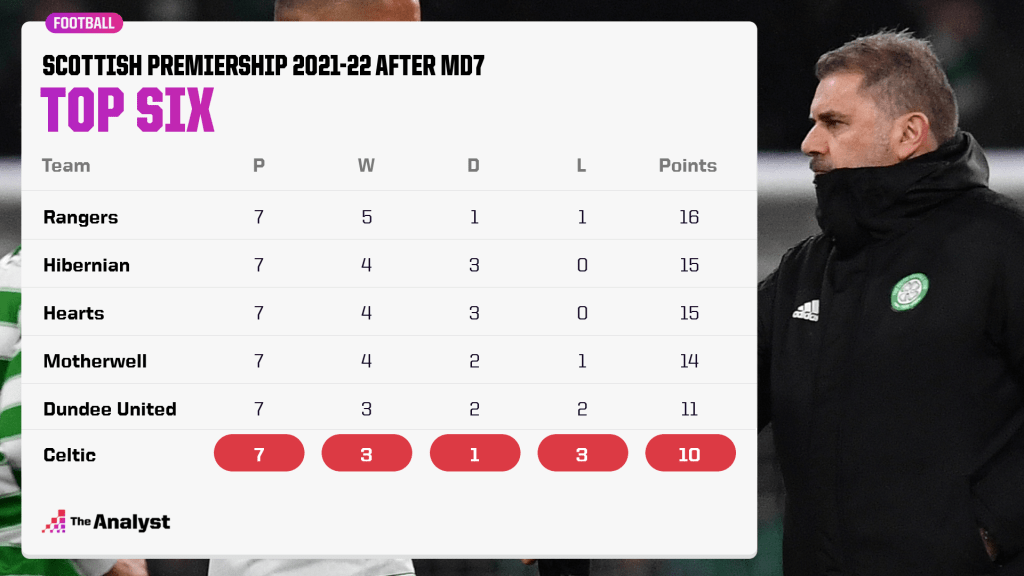
Questions were being asked about Celtic’s mentality when the chips were down, so when Aberdeen equalised through Lewis Ferguson on 56 minutes, Postecoglou’s side were in a battle to avoid a fourth defeat only eight games into the Premiership season. But Celtic’s character came through, thanks to an 84th minute winner from the influential Jota, and they haven’t looked back since.
Between October and the present day, Celtic have remained unbeaten in all 19 of their Premiership matches, with 17 of those ending in their favour. They’ve picked up 53 points from a possible 57, which is six more than rivals Rangers in the same period.
Celtic’s improvement in the table isn’t monumental compared to this stage last season – their 63-point tally is only eight more than after 26 games last season. But combined with Rangers’ decline – with their 62 points this season being 10 fewer than after 26 games of their exceptional 2020-21 campaign – an 18-point swing has occurred, and it is Celtic who can now claim the momentum heading into the final months of the Premiership season.
Having already used his previous knowledge of the Japanese top-flight to bring in the skilful Kyogo Furuhashi in the summer, Postecoglou added three more players from the J1 League in December to bolster his attacking options. Using that knowledge of the talent in Japan seems to be a tactic that’s given Celtic an edge over Rangers for the second half of the season.
After his first season in Japan at Yokohama F. Marinos, Postecoglou managed to seal a 12th place finish in the J1 League despite a poor start and took them to the final of the J-League Cup, which they eventually lost to Shonan Bellmare. His second season was far more successful, with the Marinos winning their first top-flight league title since 2004.
From the successful 2019 season through to his departure in June 2021, Postecoglou’s Marinos side became known for their high press across the J1 League, with their average PPDA (opposition passes per defensive action allowed) the lowest in the league (9.4), a league-high tally of 1319 pressed opposition passing sequences in open play (allowing the opposition only three of fewer open play passes before ending that sequence in their own half) and the second-high tally of shot-ending high turnovers in the competition over the near two and a half year period (124).
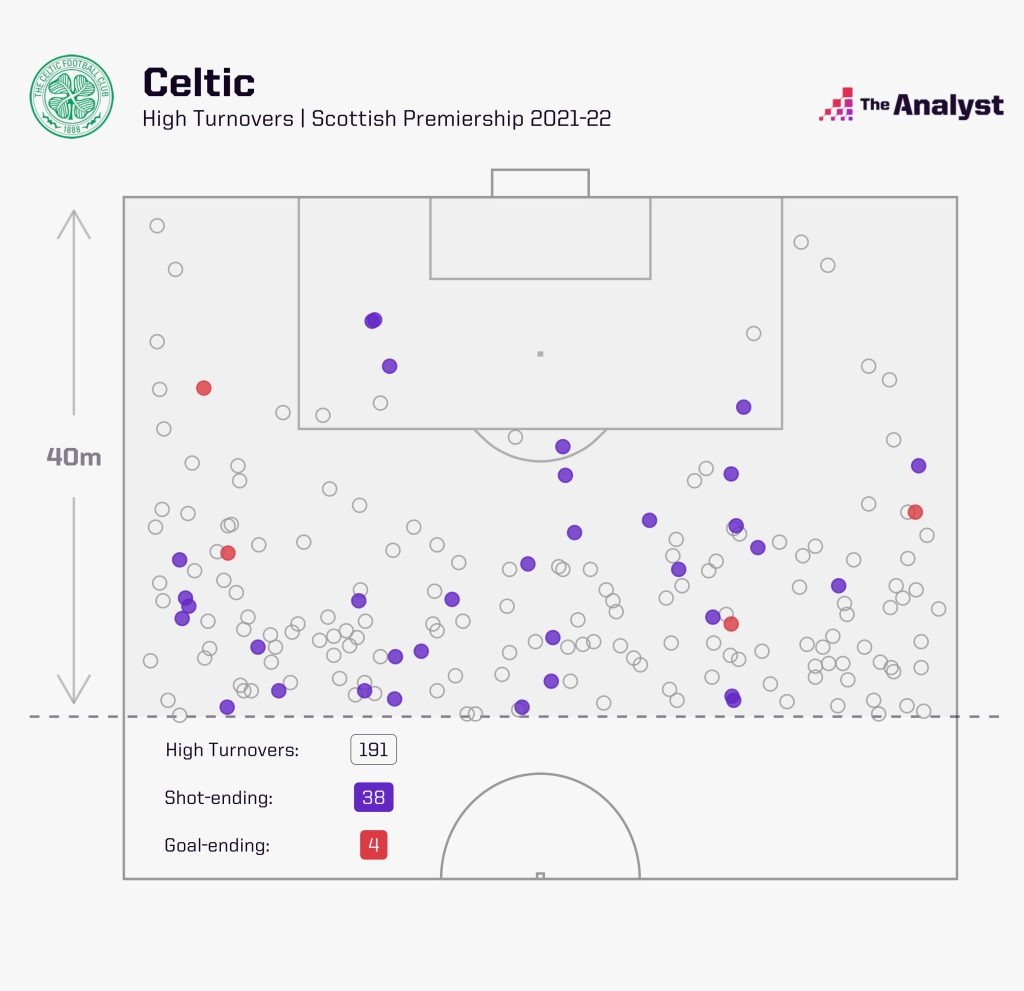
So far this season in the Scottish Premiership, Celtic have a league-low PPDA average (9.2) and have attempted the second-most shots following a high turnover (38) with a league-high four goals coming from those. In addition, their open play sequences have, on average, started 43.4 metres from their own goal – the highest starting point by any side in the Scottish top-flight this season. Postecoglou’s tactical preference to aggressively press higher up the pitch has quickly been seeded in his Celtic team.
From the start of the successful 2019 J1 League season until his departure, Yokohama F. Marinos were the leading team in the competition for average possession (64%) and average successful passes per game (560), but just 54% of those successful passes were in the opposition half – less than title-rivals Kawasaki Frontale (61%), Kashima Antlers (60%) and FC Tokyo (56%).
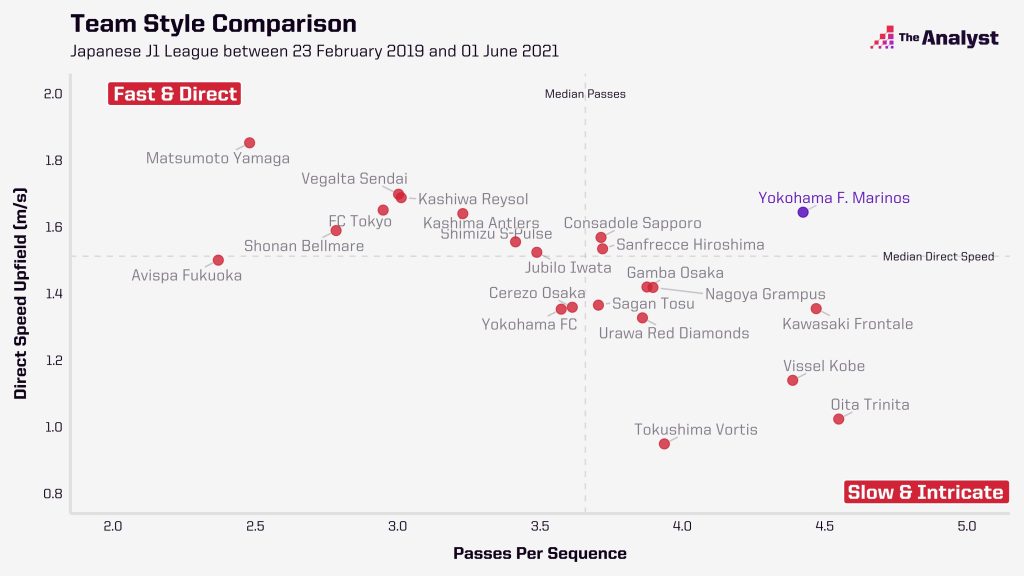
The 2021-22 Scottish top-flight season has seen a similar story for Postecoglou’s side – a league-high average possession (69.5%) and successful passes per game (564), with 56% in the opposition half. That higher proportion of passes in the opposition half is to be expected in a league dominated by the Old Firm sides (Rangers’ average is just lower, at 53%), but this is still below the Bhoys’ average in 2020-21 (57%) and 2019-20 (60%).
Field tilt is a metric to show the territorial dominance between teams. Put simply, it measures the share of possession a team has in a game, considering only touches or passes in the attacking third. It can be useful when trying to understand which team is more dominant in games, rather than looking at overall possession, mainly as it looks at how teams are able to get the ball into areas that matter.
Celtic’s field tilt average is 79% this season in the Scottish Premiership, meaning they have nearly four times as much possession in the final third as their opponents – the highest in the league ahead of Rangers (73%). Even in the Europa League this season, Celtic’s field tilt is positive (55%) and higher than well respected clubs from the top five European leagues like Lazio (51%), Monaco (49%) and Real Sociedad (51%). It’s clear that Postecoglou’s team like to take the game to the opposition.
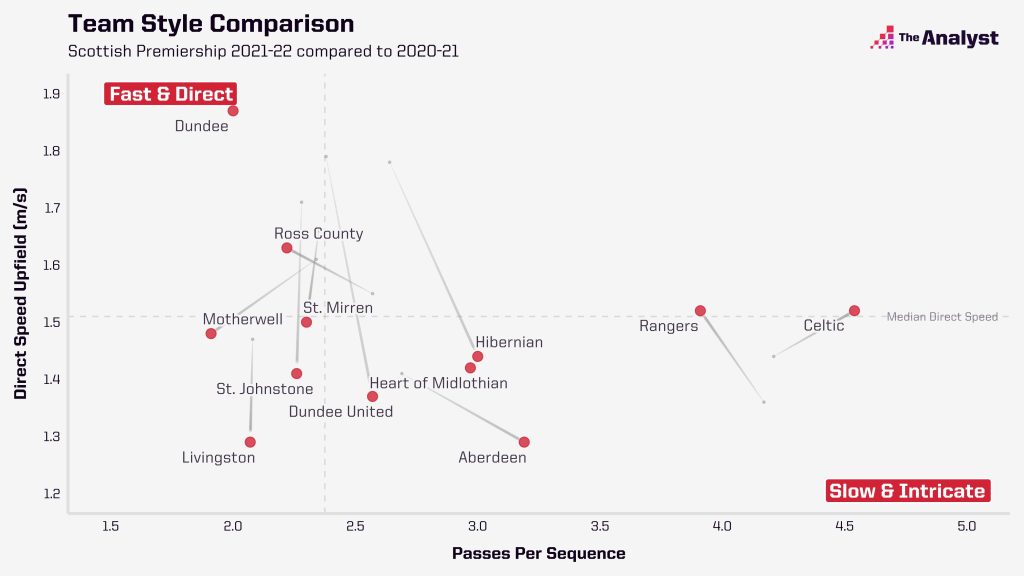
Overall, compared to 2020-21, Celtic have become slightly less ponderous with the ball; increasing the speed at which they progress the ball up the pitch whilst increasing their average passes per sequence in open play. They’ve averaged 4.5 passes per open play sequence in 2021-22, up from 4.2 in 2020-21 – not ground-breaking increase on average, but substantial enough over a season in terms of style.
Celtic conceded 25 goals in 38 Scottish Premiership games last season – not an awful record, but they came up against Steven Gerrard’s record-breaking Rangers side, who conceded an astonishing 12 at an average of less than a goal every three games.
Celtic have already conceded more goals (14) than Rangers (12) did last season, but they have – believe it or not – restricted their opponents to lower quality chances on average than that exceptional Rangers’ 2020-21 backline.
Across their title-winning campaign in 2020-21, Rangers allowed opponents an average non-penalty expected goals per game of 0.68, with Celtic’s at 0.84. Amazingly, Celtic have restricted opponents to 0.59 xG from non-penalty shots so far this season – the best in the league and even better than Rangers last season. The Gers were saved on occasions last season by a combination of woeful opposition finishing, plus inspired goalkeeping from Allan McGregor – who prevented a league-high 8.9 goals based on Opta’s expected goals on target data (facing shots totalling 16.9 xGOT).
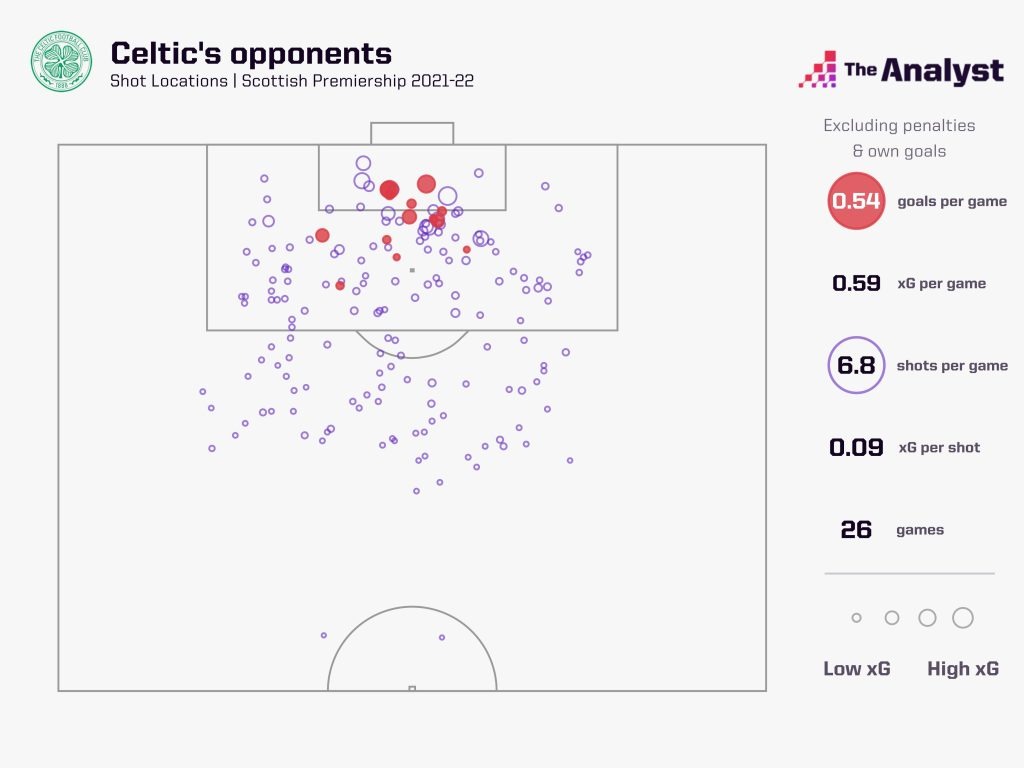
There’s been no such reliance on phenomenal goalkeeping this season by Celtic, with Joe Hart conceding at the expected rate based on the shots faced on target data (12 goals conceded from 12.3 xGOT), instead a solid defensive unit that has restricted opponents to a league-low average of 6.8 non-penalty shots per game, with the quality of those shots having the average xG of just 0.09 – lower than Rangers’ exceptional defence in 2020-21 (0.10).
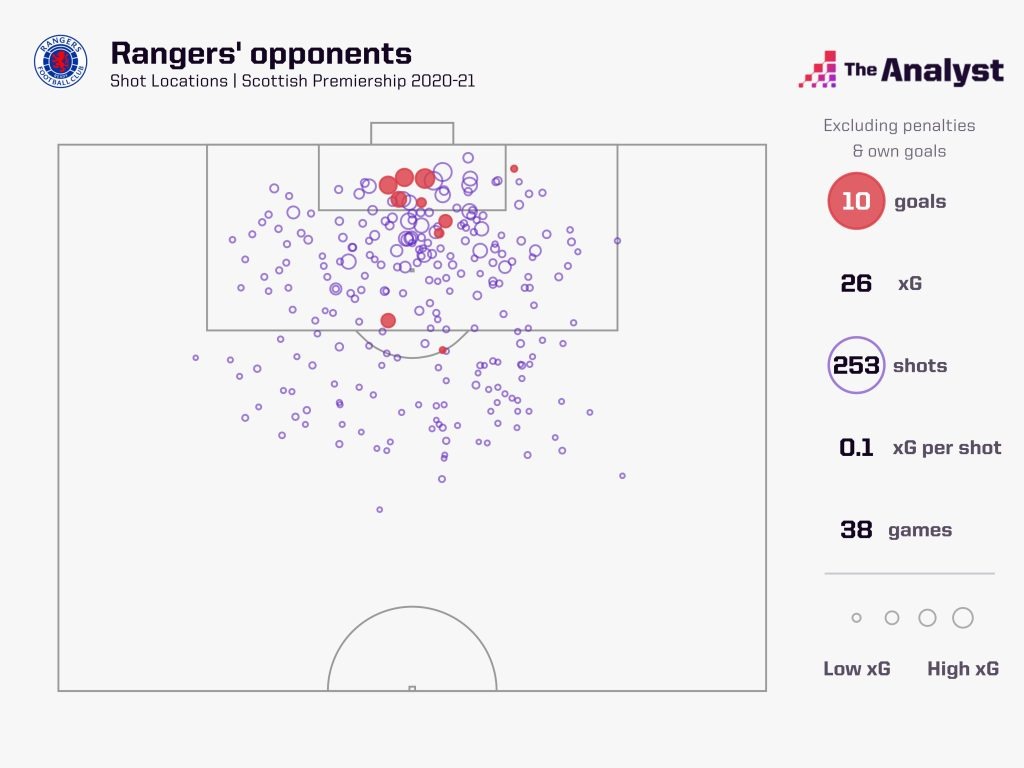
Celtic have been losing for just 6% of ball-in-play time across the Scottish Premiership season so far, a league-low proportion and less than half the ratio of Rangers (14%), but unlike Celtic – who are yet to gain a single point from a losing position, when they have fallen behind), their Glasgow rivals have already recovered 17 points from losing positions in the league, a tally that is more than any other club.
Celtic’s defensive solidarity this season is even more impressive considering the loss of Kristoffer Ajer to Brentford for £13.5million in the summer – with the Norwegian deemed one of the most talented central defenders in Scotland over the past few seasons.
In came Swedish defender Carl Starfelt from Rubin Kazan for £4million, plus the loan signing of 24-year-old Cameron Carter-Vickers from Spurs. Both have settled into central defence under Postecoglou and play a key part in progressing the ball up the pitch – only Rangers’ Connor Goldson has carried the ball further up field (4,216m) this season in the Scottish Premiership than both Carter-Vickers (3,634m) and Starfelt (3,340m).

The Spurs loanee Carter-Vickers has also been impressive in challenges both overall and aerially – his 72% duel success rate is tied with Charlie Mulgrew for the best by a defender in the league, while only two defenders have a better aerial duel success rate than the American (76%).
Of all outfield players this season, Starfelt (1937) and Carter-Vickers (1890) have played the most minutes in the Scottish Premiership for Celtic, proving both how vital the pairing is to their manager and how their understanding as a partnership has been able to develop with consistent playing time, in turn giving the club a stable backline that’s producing the results.
Whilst the defensive recruitment has aided Celtic’s improvement this season, the incoming attacking talent has produced some of their most exciting football for years.
The loss of Odsonne Édouard to Crystal Palace on the final day of the English summer transfer window was always going to be tough to stomach. The 24-year-old Frenchman had just won back-to-back top scorer awards in the Scottish Premiership, and between his debut in September 2017 and his final league appearance on 29th August 2021, Édouard (66 goals) had scored 12 more times than any other player in the Scottish top-flight.
On that same day, Celtic reinvested some of their earnings from the Édouard sale with the signing of 2020-21 Eredivisie top scorer Giorgos Giakoumakis from VVV-Venlo, while a day later in came the mercurial Jota from Benfica on loan. These were additions to the incomings of both Kyogo Furuhashi from Vissel Kobe and Liel Abada from Maccabi Petah Tikva before the season began.
With four quality acquisitions in attacking positions, it was clear that Celtic – and Postecoglou – were looking not risking a lack of firepower in their quest to win the title back.
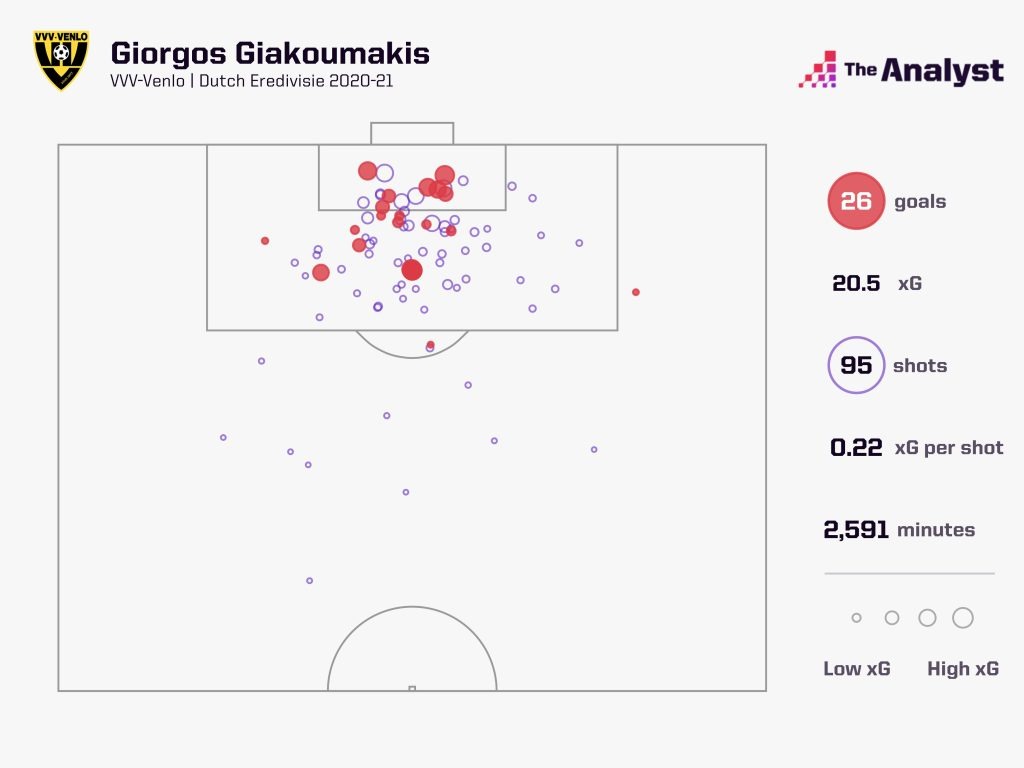
Giakoumakis felt like a coup for the club, at just a reported £2.5million. The Greek striker scored 26 goals in the Dutch top-flight last season to pick up the top scorer award, with 18 non-penalty goals coming from shots totalling just 13.5 expected goals – an overperformance of 4.6. However, it’s been a struggle for him in Scotland at the time of writing, with only four goals in 16 competitive appearances.
He’s been overshadowed by Abada’s performances, so far. The Israeli was thrown in from the off, with him making his debut in Postecoglou’s first competitive game at the club; the Champions League qualifier against Midtjylland, where he also scored. Even his boss seemed surprised about his impact in Glasgow when questioned by the Daily Record in November, stating “to be honest, when I signed him, I thought he was one we would ease into proceedings with James (Forrest) out there having experience. But he’s one of those guys we threw in there to sink or swim and most of them have had a decent swim up until now.”
Abada is currently Celtic’s top scorer in the Scottish Premiership with nine goals, while no player has more assists than the 20-year-old (6). One of his key attributes this season has been the ability to find great shooting positions in the box after drifting in off the wing – often under the radar of opposition defences, as we saw in the recent Old Firm derby win against Rangers. His expected goals total of 11.2 is second only to Rangers’ Alfredo Morelos (13.4) in the competition this season, at an average of 0.58 per 90.
The leading player for expected goals per 90 in the Scottish Premiership this season is another summer signing, Japanese forward Kyogo Furuhashi (0.98).
Furuhashi suffered a hamstring injury that’s kept him out of action since Boxing Day but began the season in electric form. Of course, Postecoglou knew all about the threat posed by the former Vissel Kobe forward from his time in Japan. At the time of his departure for Celtic in July, Furuhashi led the 2021 J1 League for goals (15) and shot involvements from ball carries (39), while he also posted the highest non-penalty xG total in the competition (11.4).
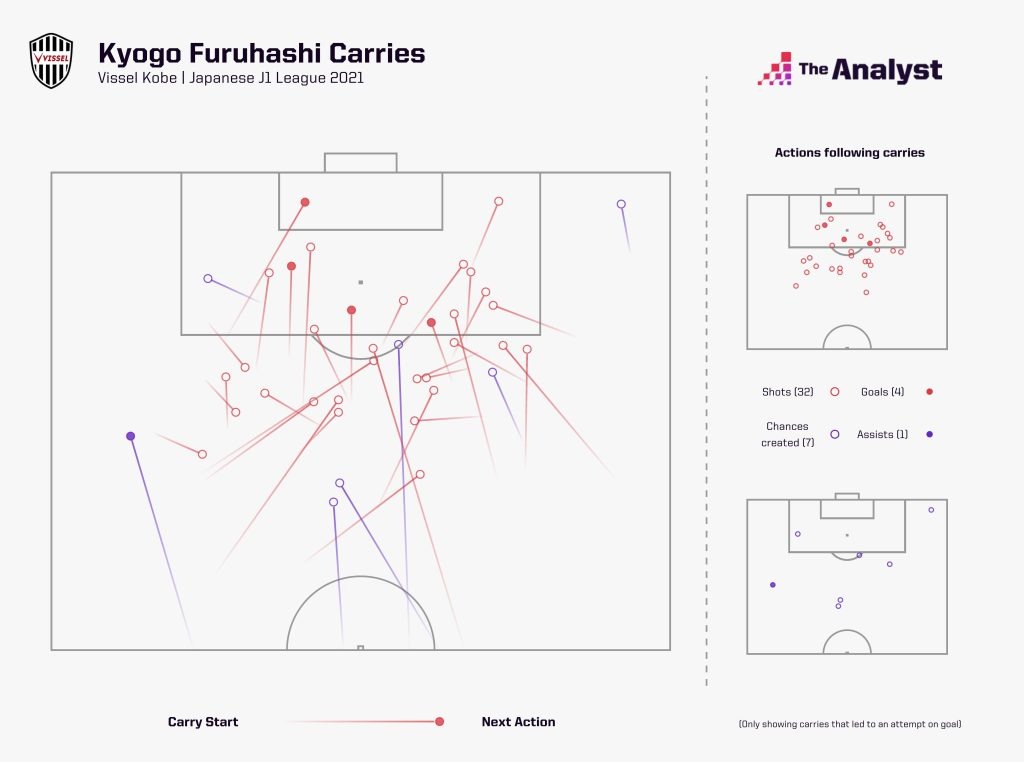
So far in his Celtic career, he’s scored 13 goals and assisted two more in 22 competitive appearances and will be key to Celtic’s chances of winning the title come the end of the season.
Yet another coup for Celtic in the summer transfer window came with the loan signing of Benfica’s Jota. The Portuguese has averaged a shot involvement following a ball carry every 40 minutes this season in the league (31 in 1,264 minutes), a faster rate than any of the eight players to have been involved in at least 27 shots in this manner. His open play expected assists per 90 average of 0.33 is the third-best in the league this season behind only teammates Liel Abada (0.34) and Tomas Rogic (0.38).
Overall, in the Scottish Premiership this season, the leading player for expected assists (including set pieces) is David Turnbull (0.43).
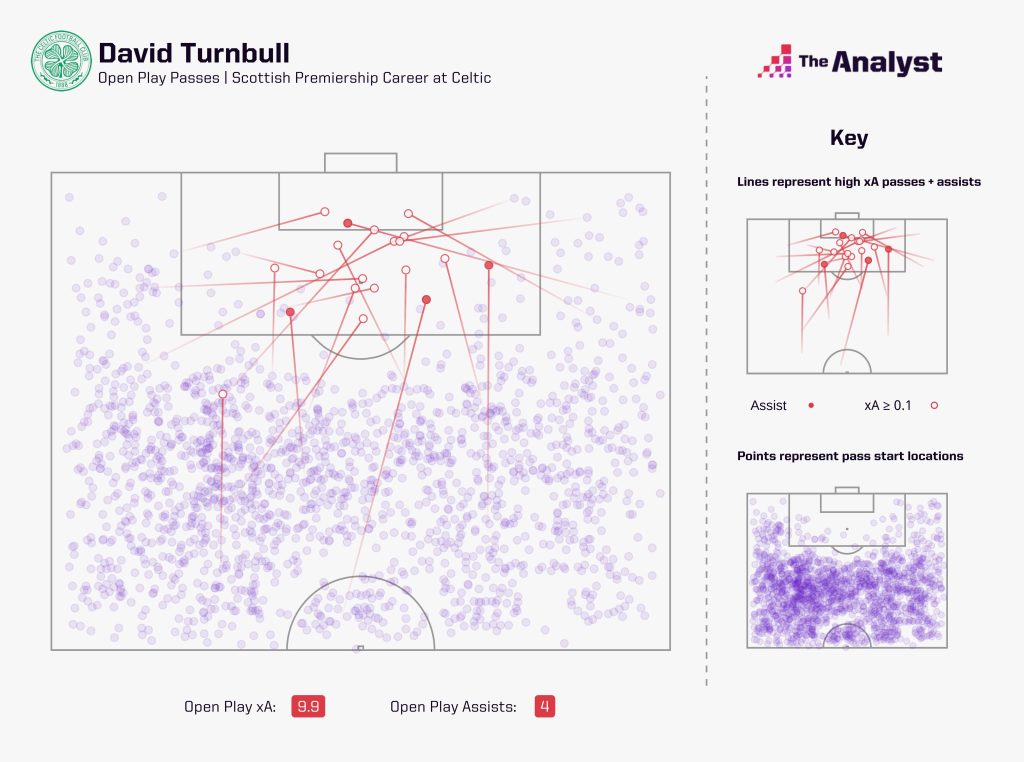
After seeing a move to Celtic in the summer of 2019 ruined thanks to a terrible knee injury, Turnbull’s move to the Bhoys eventually came just over a year later following a long spell of rehabilitation. Celtic were willing to wait for their man as they knew what he would eventually bring.
We pinpointed him as a man to watch for Scotland at Euro 2020, but despite an excellent 2020-21 domestic season at Celtic, where he excelled in various attacking metrics, he didn’t get given a single minute of action at the tournament. He’s doing the same again in 2021-22, with the 22-year-old the player with the most attacking sequence involvements in the Scottish Premiership (177) – a clear display of how involved Turnbull is in everything good for the league leaders this season.
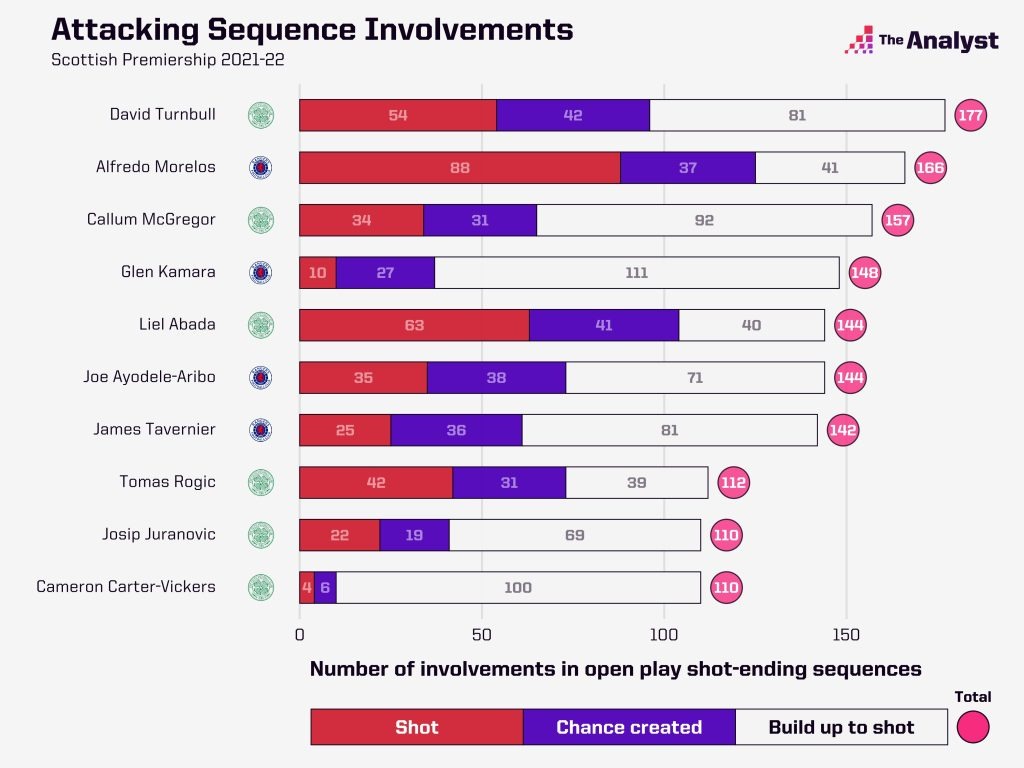
Even though Celtic’s form had turned for the better ahead of the new year, they still found themselves six points behind leaders Rangers on 31st December. A fresh impetus was needed, and it came via a trio of signings from the Japanese top-flight.
Naturally, Postecoglou’s advantage over many in European football is his key knowledge of the J1 league and its players, so he would have been stupid not to utilise it. Celtic announced the arrival of Daizen Maeda, Yosuke Ideguchi and Reo Hatate during the winter break, and it took only four minutes of league action for Celtic fans to see their positive impact.
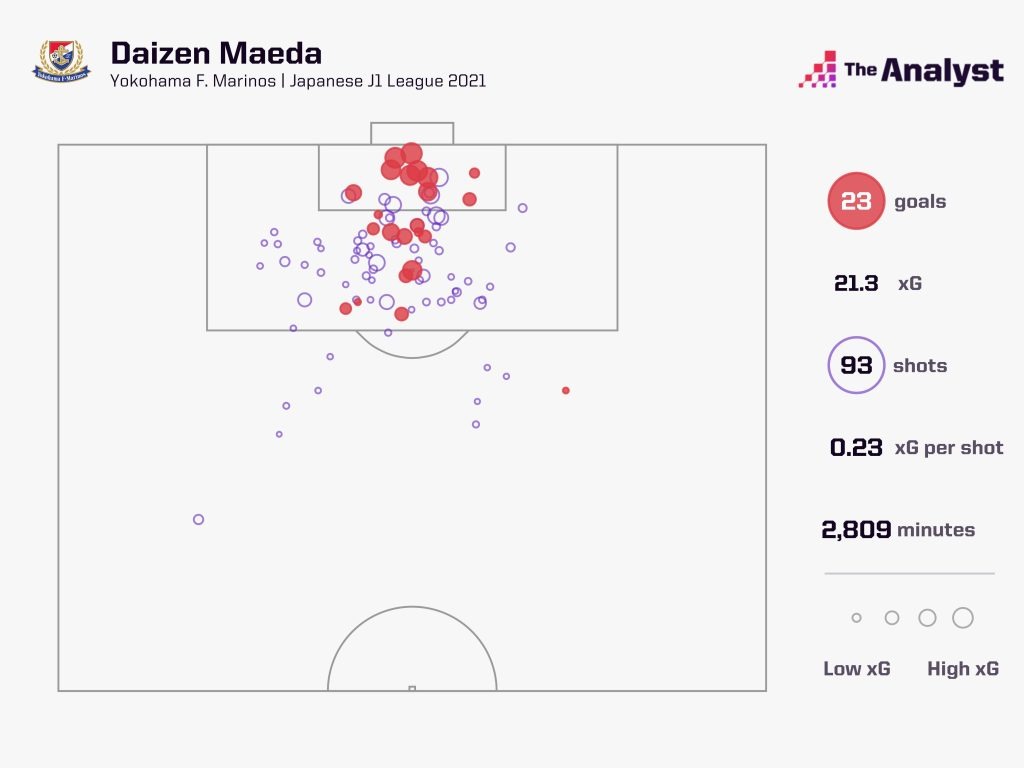
Maeda calmly slotted past Hibernian goalkeeper Matt Macey only three minutes and 39 seconds into his Scottish top-flight career, with his first shot for the club. This came following a brilliant Japanese league season for the 24-year-old, in which he topped the J1 league goal rankings (23), tallied the highest xG total (21.3) and converted an impressive 24.7% of shots. This was his best season during his career, and he arrived in Scotland on the crest of a wave.
In Reo Hatate, Celtic purchased a winner. The 24-year-old came to Scotland fresh from winning the J1 League with Kawasaki Frontale, where he weighed in with seven goal involvements across 30 appearances (five goals, two assists) – he’s already only two away from that tally in the Scottish Premiership since joining Celtic (three goals, two assists) in just 426 minutes of action. His debut against Hibs saw him win man of the match, while his magical performance in the Old Firm derby against Rangers on 2nd February saw him score the opening two goals before assisting the third for Abada – all before half-time.
Unfortunately for Celtic and Ideguchi – the third of Celtic’s Japanese arrivals in December, he sustained an injury in only his second appearance for the club following a strong challenge against Alloa. However, he made his return in Celtic’s cup win over Raith this weekend so adds to an already strong squad for the season run in.
The signing of MK Dons’ midfielder Matt O’Riley was overshadowed by the trio of arrivals from Japan in the winter transfer window, but so far, his signature seems just as astute. Since the turn of the year, no player has created as many chances for teammates as the former England youth international – both overall (20) and from open play (18).
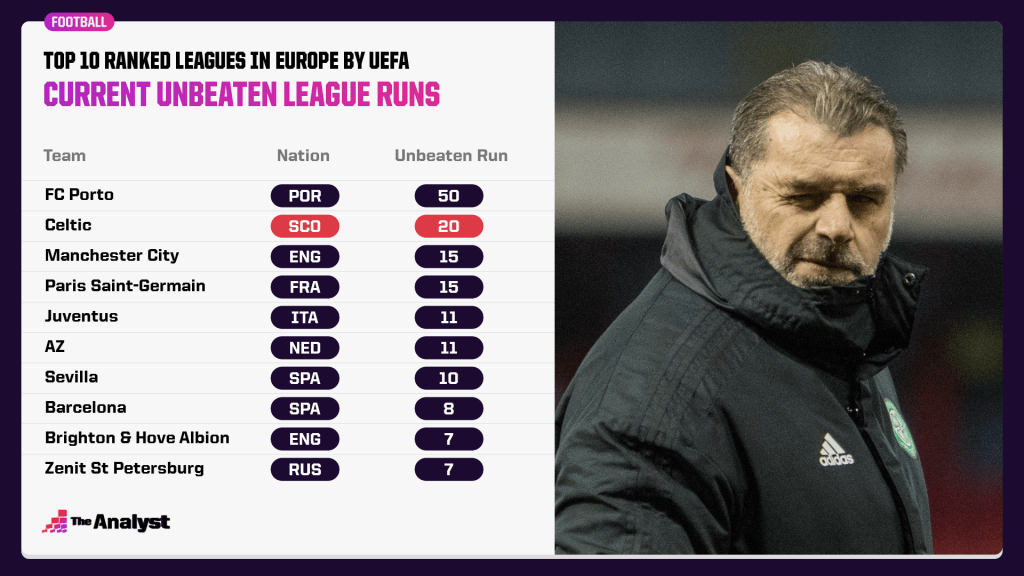
Ange Postecoglou took a while to find his feet at the club following a huge shift in culture between new and old clubs, but those feet seem firmly grounded now.
Celtic have seven games remaining before the league split for matchdays 34-38, with two of their final 12 league matches coming against rivals Rangers. They’ve already won the League Cup thanks to their 2-1 win over Hibernian in December, while they now find themselves in the Scottish Cup quarter final following this weekend’s 4-0 victory over Raith Rovers at Celtic Park.
With Celtic one of the stronger teams left in the inaugural UEFA Europa Conference League and the Scottish Premiership now in their hands with a one-point lead over Rangers, Postecoglou is in with a shout of winning a quadruple in his debut season. The only time that they’ve secured the domestic treble and a European trophy win was in 1966-67 thanks to Jock Stein’s exceptional Lisbon Lions. They couldn’t do it again, could they?
Enjoy this? Subscribe to our mailing list to receive exclusive weekly content.
